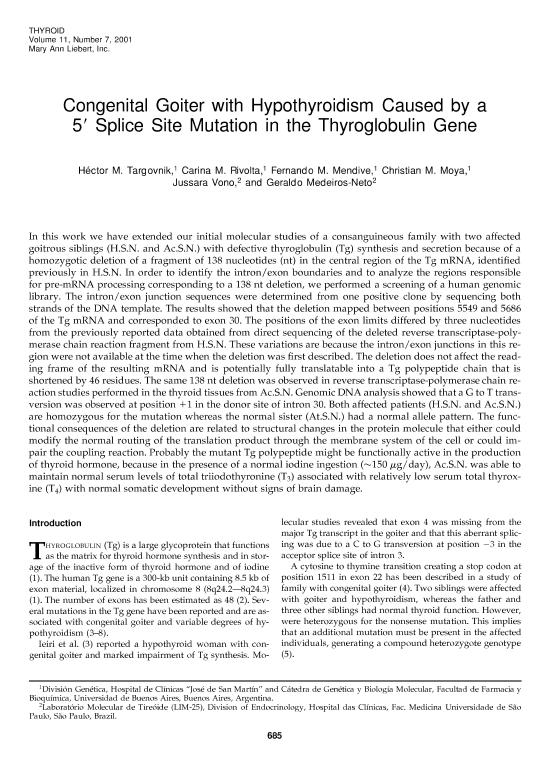Artículo
Congenital goiter with hypothyroidism caused by a 5′ splice site mutation in the thyroglobulin gene
Targovnik, Hector Manuel ; Rivolta, Carina Marcela
; Rivolta, Carina Marcela ; Mendive, Fernando M.; Moya, Christian M.; Vono, Jussara; Medeiros Neto, Geraldo
; Mendive, Fernando M.; Moya, Christian M.; Vono, Jussara; Medeiros Neto, Geraldo
 ; Rivolta, Carina Marcela
; Rivolta, Carina Marcela ; Mendive, Fernando M.; Moya, Christian M.; Vono, Jussara; Medeiros Neto, Geraldo
; Mendive, Fernando M.; Moya, Christian M.; Vono, Jussara; Medeiros Neto, Geraldo
Fecha de publicación:
07/2001
Editorial:
Mary Ann Liebert
Revista:
Thyroid
ISSN:
1050-7256
Idioma:
Inglés
Tipo de recurso:
Artículo publicado
Clasificación temática:
Resumen
In this work we have extended our initial molecular studies of a consanguineous family with two affected goitrous siblings (H.S.N. and Ac.S.N.) with defective thyroglobulin (Tg) synthesis and secretion because of a homozygotic deletion of a fragment of 138 nucleotides (nt) in the central region of the Tg mRNA, identified previously in H.S.N. In order to identify the intron/exon boundaries and to analyze the regions responsible for pre-mRNA processing corresponding to a 138 nt deletion, we performed a screening of a human genomic library. The intron/exon junction sequences were determined from one positive clone by sequencing both strands of the DNA template. The results showed that the deletion mapped between positions 5549 and 5686 of the Tg mRNA and corresponded to exon 30. The positions of the exon limits differed by three nucleotides from the previously reported data obtained from direct sequencing of the deleted reverse transcriptase-polymerase chain reaction fragment from H.S.N. These variations are because the intron/exon junctions in this region were not available at the time when the deletion was first described. The deletion does not affect the reading frame of the resulting mRNA and is potentially fully translatable into a Tg polypeptide chain that is shortened by 46 residues. The same 138 nt deletion was observed in reverse transcriptase-polymerase chain reaction studies performed in the thyroid tissues from Ac.S.N. Genomic DNA analysis showed that a G to T transversion was observed at position +1 in the donor site of intron 30. Both affected patients (H.S.N. and Ac.S.N.) are homozygous for the mutation whereas the normal sister (At.S.N.) had a normal allele pattern. The functional consequences of the deletion are related to structural changes in the protein molecule that either could modify the normal routing of the translation product through the membrane system of the cell or could impair the coupling reaction. Probably the mutant Tg polypeptide might be functionally active in the production of thyroid hormone, because in the presence of a normal iodine ingestion (∼150 μg/day), Ac.S.N. was able to maintain normal serum levels of total triiodothyronine (T3) associated with relatively low serum total thyroxine (T4) with normal somatic development without signs of brain damage.
Palabras clave:
CONGENITAL GOITER
,
HYPOTHYROIDISM
,
THYROGLOBULIN
,
SPLICE SITE MUTATION
Archivos asociados
Licencia
Identificadores
Colecciones
Articulos(INIGEM)
Articulos de INSTITUTO DE INMUNOLOGIA, GENETICA Y METABOLISMO
Articulos de INSTITUTO DE INMUNOLOGIA, GENETICA Y METABOLISMO
Citación
Targovnik, Hector Manuel; Rivolta, Carina Marcela; Mendive, Fernando M.; Moya, Christian M.; Vono, Jussara; et al.; Congenital goiter with hypothyroidism caused by a 5′ splice site mutation in the thyroglobulin gene; Mary Ann Liebert; Thyroid; 11; 7; 7-2001; 685-690
Compartir
Altmétricas



